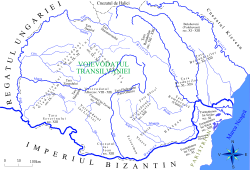Draft:Jupanat of Dimitrie
 | Review waiting, please be patient.
This may take 2 months or more, since drafts are reviewed in no specific order. There are 2,969 pending submissions waiting for review.
Where to get help
How to improve a draft
You can also browse Wikipedia:Featured articles and Wikipedia:Good articles to find examples of Wikipedia's best writing on topics similar to your proposed article. Improving your odds of a speedy review To improve your odds of a faster review, tag your draft with relevant WikiProject tags using the button below. This will let reviewers know a new draft has been submitted in their area of interest. For instance, if you wrote about a female astronomer, you would want to add the Biography, Astronomy, and Women scientists tags. Editor resources
Reviewer tools
|
 Comment: The draft has an unusual, almost narrative style like "There was once a jupan...", which is not in line with Wikipedia’s neutral, encyclopedic tone. Even if the subject is notable, the article would need significant rewriting for style and tone in addition to stronger sourcing.Cameremote (talk) 14:26, 20 September 2025 (UTC)
Comment: The draft has an unusual, almost narrative style like "There was once a jupan...", which is not in line with Wikipedia’s neutral, encyclopedic tone. Even if the subject is notable, the article would need significant rewriting for style and tone in addition to stronger sourcing.Cameremote (talk) 14:26, 20 September 2025 (UTC)

Circa 943, there was a jupan[2] named Dimitrie,[3][4] who ruled over the Jupanat of Dimitrie.[5]
Dimitrie
[edit]It is likely that Dimitrie was of Vlach origin and had separated from Bulgaria after the death of Tsar Simeon I in 927. He was a chieftain, and led the fortified settlement where the tablet was discovered. Dimitrie probably died fighting Byzantines, identified as Greeks.[4]
Tablet
[edit]
A tablet, dated 943, was discovered in 1950 in the ruins of a small fort near the present-day commune of Mircea Vodă, Constanța. It is in Old Slavonic, and mentions a certain jupan named Dimitrie.[4][6]
The tablet itself is stone and is parallelepiped-shaped. One side has a well-polished groove in the form of a channel, that is 13 centimetres (5.11811 inches), probably from an initial use. On the other side there is a fragment of an inscription in Old Slavonic.[7]
References
[edit]- ^ Ovidiu Drimba - Istoria culturii şi civilizaţiei româneşti [History of Romanian culture and civilisation], Editura Ştiinţifică şi Pedagogică, Bucureşti, 1987, vol.2, pag.404
- ^ Dogaru, Mircea; Zahariade, Mihail (1996). History of the Romanians: From the origins to the modern age. Amco Press Pub. p. 131. ISBN 9789739675598.
- ^ Dicţionar de istorie veche a României [Dictionary of ancient history of Romania], Editura Științifică și Enciclopedică (1976)
- ^ a b c Negre, Poveștile Mării (2014-02-20). "Mircea Vodă - Jupan Dimitrie și inscriptia slavă" [Mircea Vodă - Jupan Dimitrie and the Slavic inscription]. Povestile Marii Negre (in Romanian). Retrieved 2025-09-18.
- ^ Treptow, Kurt W. (1996). A History of Romania (in Romanian). p. 7.
- ^ "Constanţa (Tomis)". Itinerarii pontice (in Romanian). 2013-09-07. Retrieved 2025-09-19.
- ^ "Bunuri culturale mobile clasate în Patrimoniul Cultural Naţional" [Mobile Cultural Objects Listed in the National Cultural Heritage]. clasate.cimec.ro (in Romanian). Retrieved 2025-09-19.